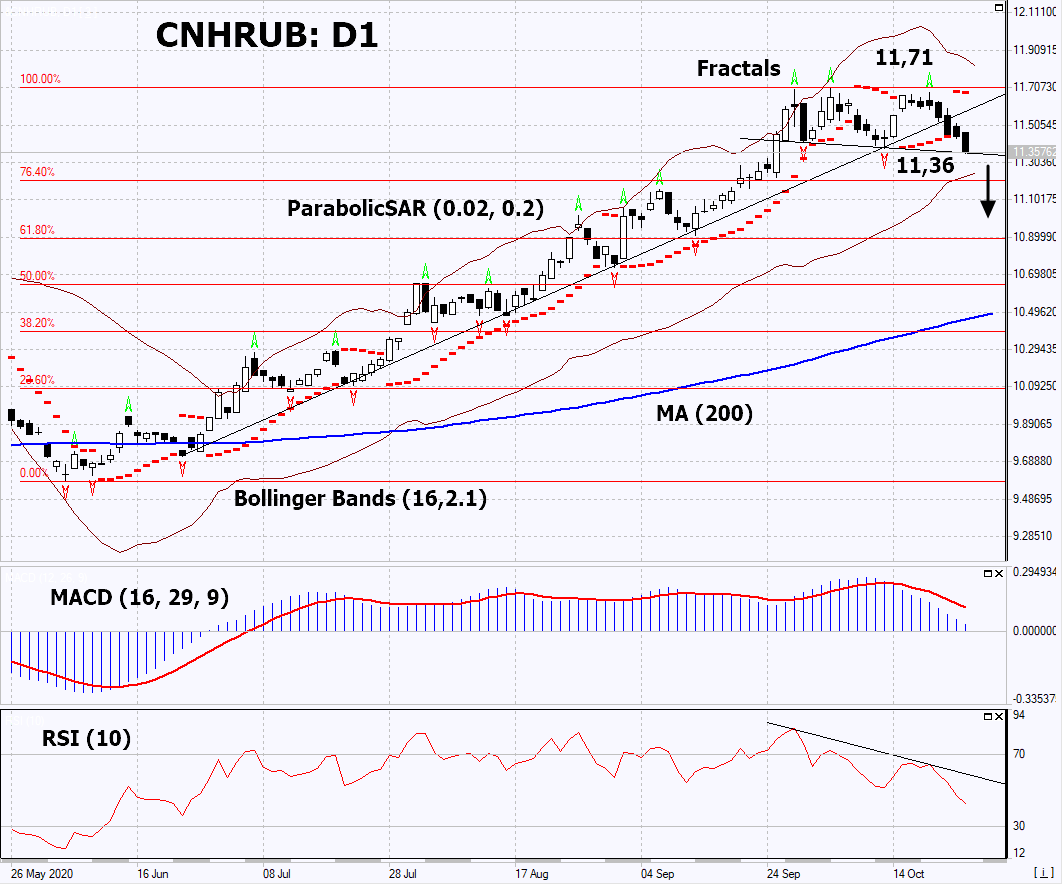- Analiz
- Teknik analiz
Ruble'ye karşı Yuan Teknik Analiz - Ruble'ye karşı Yuan Ticaret: 2020-10-27
Ruble'ye karşı Yuan Teknik Analiz Özeti
Below 11,36
Sell Stop
Above 11,71
Stop Loss
| Gösterge | Sinyal |
| RSI | Nötr |
| MACD | Sat |
| MA(200) | Nötr |
| Fractals | Sat |
| Parabolic SAR | Sat |
| Bollinger Bands | Nötr |
Ruble'ye karşı Yuan Grafik analizi
Ruble'ye karşı Yuan Teknik analiz
On the daily timeframe, CNHRUB: D1 broke down the uptrend support line and is trying to correct downward from the maximum since February 2016. A number of technical analysis indicators generated signals for further decline. We do not rule out a bearish movement if CNHRUB falls below its latest minimum: 11.35. This level can be used as an entry point. We can place a stop loss above the maximum since February 2016, the last high fractal and the Parabolic signal: 11.71. After opening a pending order, we move the stop loss to the next fractal maximum following the Bollinger and Parabolic signals. Thus, we change the potential profit/loss ratio in our favor. After the transaction, the most risk-averse traders can switch to the 4-hour chart and set a stop loss, moving it in the direction of the bias. If the price meets the stop loss (11.71) without activating the order (11.35), it is recommended to delete the order: some internal changes in the market have not taken been into account.
Temel analiz PCI - Ruble'ye karşı Yuan
In this review, we propose to consider the "&CNHRUB" Personal Composite Instrument (PCI). It reflects the price dynamics of the Chinese yuan against the Russian ruble. Will the CNHRUB quotes continue to decrease?
The downward movement means the strengthening of the ruble and the weakening of the yuan. The Chinese currency was slightly lower amid the data on GDP growth for the 3rd quarter by 4.9% qoq, though it was expected to amount to 5.2%. Russian's current yield on 10-year government bonds is 6.2% (in rubles). In China, it is lower, at 3.2% (in yuan). Perhaps the dynamics of this PCI may depend on strengthening or softening of US sanctions against Russia or China after the US presidential election. In the meantime, Chinese authorities have expressed concern about the renminbi’s excessive rise to a 27-month maximum against the greenback. In theory, People’s Bank of China can take any steps to ease the monetary policy. The Bank of Russia, on the contrary, strives to support the ruble exchange rate. Since early 2020, it has already collapsed by almost a quarter amid falling world oil prices due to the coronavirus pandemic.
Not:
Bu bilgilendirici ve eğitici bir genel bakıştır ve ücretsiz olarak yayımlanmaktadır. Burada yer alan tüm veriler kamu kaynaklarından alınmış ve az çok güvenilir olarak kabul edilmiştir. Aynı zamanda, bilgilerin tam ve doğru olduğuna dair hiçbir garanti yoktur. Gelecekte bunlar güncellenmemektedirler. Görüşler, göstergeler, grafikler ve kalan her şey dahil olmak üzere her genel bakışta olan tüm bilgiler sadece değerlendirme amacıyla sağlanıp mali dalışmanlık veya tavsiye niteliğinde değildirler. Tüm metin ve onun herhangi bir bölümünü veya grafikleri herhangi bir varlıkla işlem yapmak için bir teklif olarak kabul edilemez. IFC Markets şirketi ve şirket çalışanları bu genel bakışın incelenmesi sırasında veya sonrasında başkası tarafından alınan herhangi bir eylem için hiçbir koşulda sorumlu değildir.


